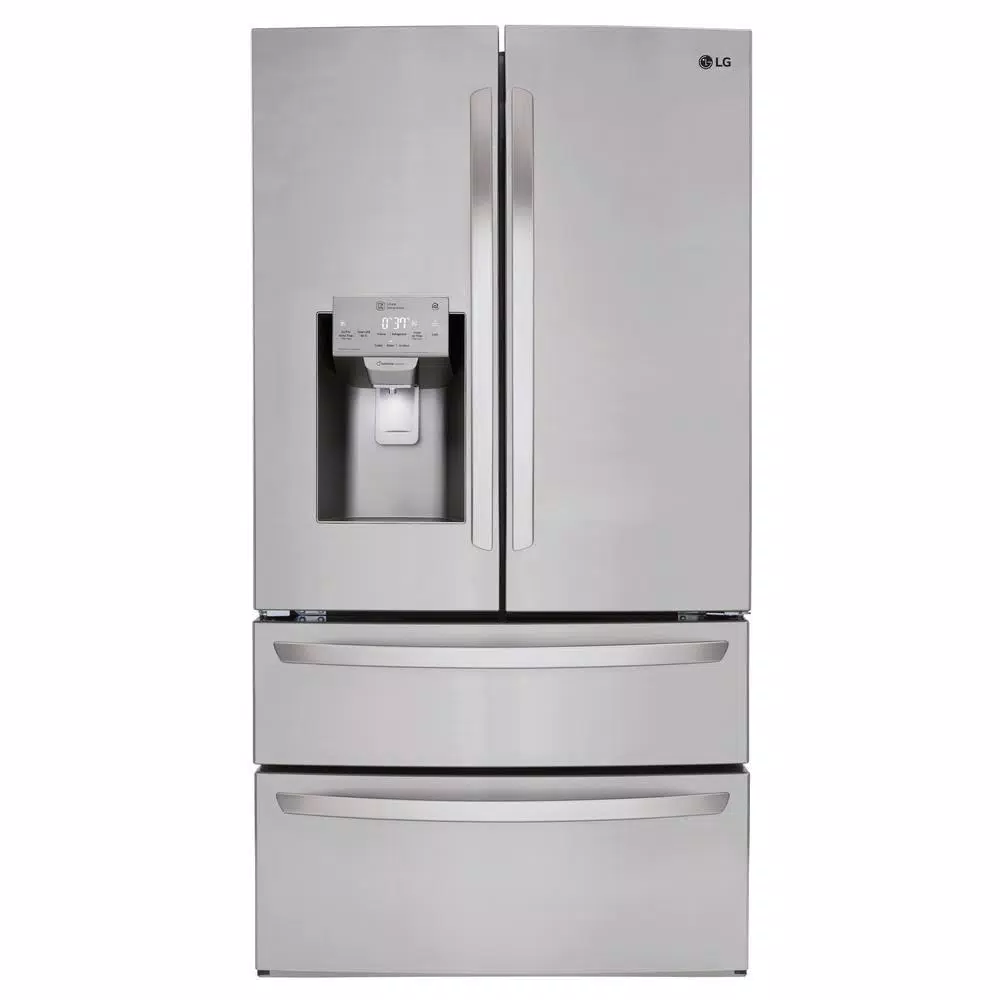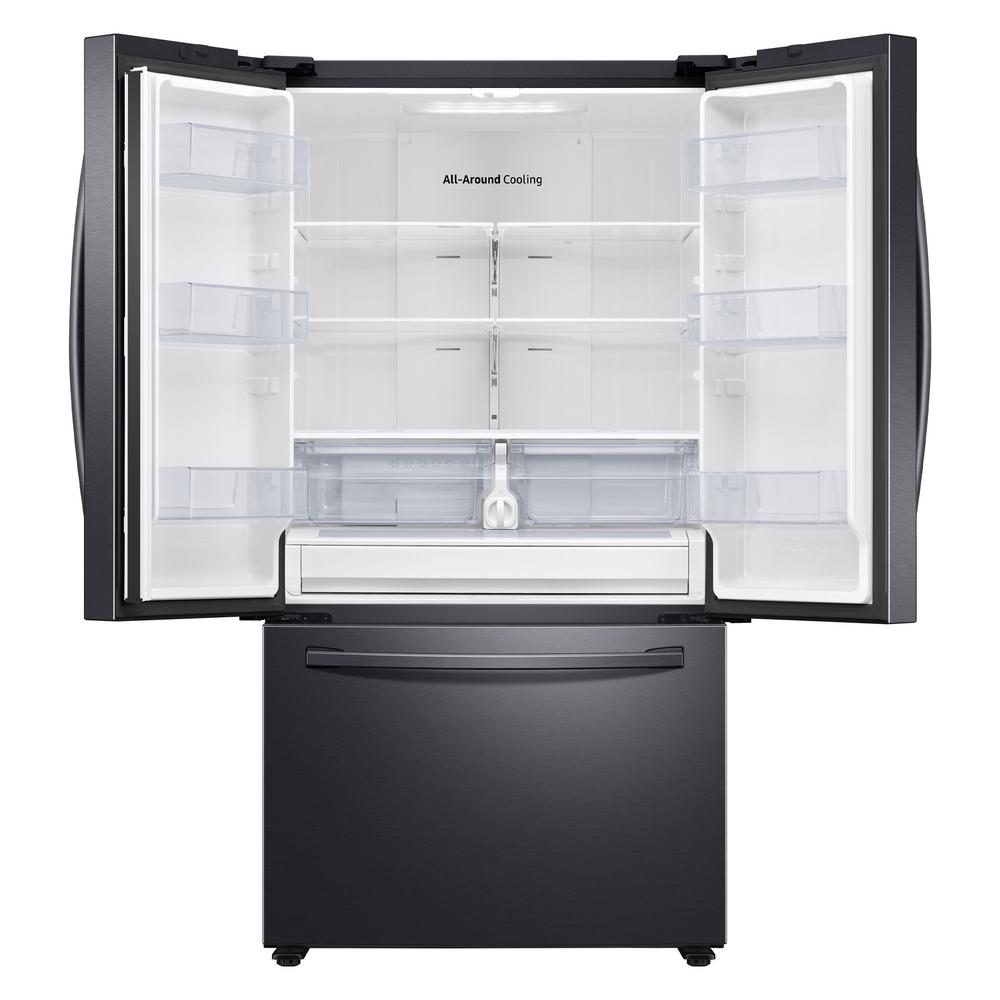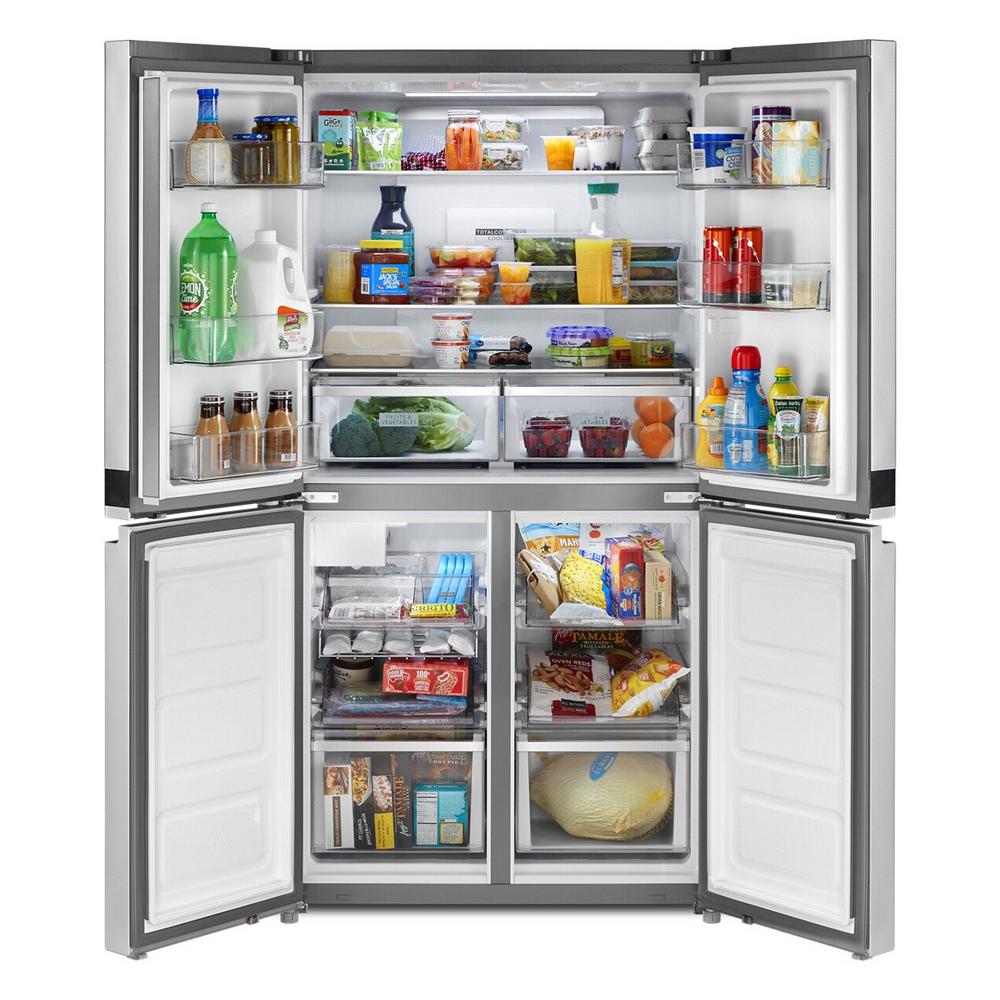Samsung 28 cu. ft. Smart Side-by-Side Refrigerator in Fingerprint Resistant Stainless Steel
More space, more ways to stay organized. Seamlessly designed for a modern look. Fingerprint Resistant Finish.
Large capacity Smart Side-by-Side Refrigerator with In-Door Ice Maker is beautifully designed with a modern look that blends seamlessly into your kitchen and a finish that withstands everyday smudges. A completely redesigned interior with 28 cu. ft. capacity that fits 10% more groceries than ever. A modern look featuring a minimalist exterior with signature flat-door design and recessed handles that seamlessly blend into your kitchen.
- A completely redesigned interior with 28 cu. ft. capacity that fits 10% more groceries than ever
- A modern look featuring a minimalist exterior with signature flat-door design and recessed handles that seamlessly blend into your kitchen
- A finish that withstands everyday smudges, so you spend less time cleaning
- Multi-vent technology keeps items on every shelf evenly cooled
- High-capacity, in-door ice maker with detachable ice bucket that saves shelf space for your frozen foods
- Use the Samsung SmartThings App on your smartphone to control the temperature and monitor your refrigerator remotely
- Bright LED lighting designed to beautifully light up the interior of your fridge so you can quickly spot what you want
- Easy-to-reach controls for everyone
- Beautifully designed with a modern look that blends seamlessly into your kitchen and a finish that withstands everyday smudges
- When compared to Samsung Standard Depth Side-by-Side model RS25J500D with 24.52 cu. ft. capacity
- Available on Android and iOS devices, a Wi-Fi connection and a Samsung account are required
Additional information
| Depth (Excluding Handles) | 33.5 in |
|---|---|
| Depth (Including Handles) | 33.5 in |
| Depth (Less Door) | 28.94 in |
| Depth With Door Open 90 Degrees (In) | 51.31 |
| Height to Top of Door Hinge (in.) | 70.06 |
| Height to Top of Refrigerator (in.) | 68.62 |
| Product Depth x Height x Width (in.) | 33.5 x 70.06 x 35.87 |
| Refrigerator Width (In.) | 35.87 |
| Certifications and Listings | UL Certified |
| Manufacturer Warranty | 1 Year Parts/Labor (Five (5) years Parts and Labor on sealed Refrigeration system only* Ten (10) years Part and Five (5) years Labor on Digital Inverter Compressor (*Compressor, evaporator, condenser, drier, connecting tubing)) |
Twenty-eight or 28 may refer to:
- 28 (number), the natural number following 27 and preceding 29
- one of the years 28 BC, AD 28, 1928, 2028
A fingerprint is an impression left by the friction ridges of a human finger. The recovery of partial fingerprints from a crime scene is an important method of forensic science. Moisture and grease on a finger result in fingerprints on surfaces such as glass or metal. Deliberate impressions of entire fingerprints can be obtained by ink or other substances transferred from the peaks of friction ridges on the skin to a smooth surface such as paper. Fingerprint records normally contain impressions from the pad on the last joint of fingers and thumbs, though fingerprint cards also typically record portions of lower joint areas of the fingers.
Human fingerprints are detailed, unique, difficult to alter, and durable over the life of an individual, making them suitable as long-term markers of human identity. They may be employed by police or other authorities to identify individuals who wish to conceal their identity, or to identify people who are incapacitated or deceased and thus unable to identify themselves, as in the aftermath of a natural disaster.
Their use as evidence has been challenged by academics, judges and the media. There are no uniform standards for point-counting methods, and academics have argued that the error rate in matching fingerprints has not been adequately studied and that fingerprint evidence has no secure statistical foundation. Research has been conducted into whether experts can objectively focus on feature information in fingerprints without being misled by extraneous information, such as context.
A refrigerator, commonly fridge, is a commercial and home appliance consisting of a thermally insulated compartment and a heat pump (mechanical, electronic or chemical) that transfers heat from its inside to its external environment so that its inside is cooled to a temperature below the room temperature. Refrigeration is an essential food storage technique around the world. The low temperature reduces the reproduction rate of bacteria, so the refrigerator lowers the rate of spoilage. A refrigerator maintains a temperature a few degrees above the freezing point of water. The optimal temperature range for perishable food storage is 3 to 5 °C (37 to 41 °F). A freezer is a specialized refrigerator, or portion of a refrigerator, that maintains its contents’ temperature below the freezing point of water. The refrigerator replaced the icebox, which had been a common household appliance for almost a century and a half. The United States Food and Drug Administration recommends that the refrigerator be kept at or below 4 °C (40 °F) and that the freezer be regulated at −18 °C (0 °F).
The first cooling systems for food involved ice. Artificial refrigeration began in the mid-1750s, and developed in the early 1800s. In 1834, the first working vapor-compression refrigeration, using the same technology seen in air conditioners, system was built. The first commercial ice-making machine was invented in 1854. In 1913, refrigerators for home use were invented. In 1923 Frigidaire introduced the first self-contained unit. The introduction of Freon in the 1920s expanded the refrigerator market during the 1930s. Home freezers as separate compartments (larger than necessary just for ice cubes) were introduced in 1940. Frozen foods, previously a luxury item, became commonplace.
Freezer units are used in households as well as in industry and commerce. Commercial refrigerator and freezer units were in use for almost 40 years prior to the common home models. The freezer-over-refrigerator style had been the basic style since the 1940s, until modern, side-by-side refrigerators broke the trend. A vapor compression cycle is used in most household refrigerators, refrigerator–freezers and freezers. Newer refrigerators may include automatic defrosting, chilled water, and ice from a dispenser in the door.
Domestic refrigerators and freezers for food storage are made in a range of sizes. Among the smallest are Peltier-type refrigerators designed to chill beverages. A large domestic refrigerator stands as tall as a person and may be about one metre (3 ft 3 in) wide with a capacity of 0.6 m3 (21 cu ft). Refrigerators and freezers may be free standing, or built into a kitchen. The refrigerator allows the modern household to keep food fresh for longer than before. Freezers allow people to buy perishable food in bulk and eat it at leisure, and make bulk purchases.
Samsung Group (Korean: 삼성; Hanja: 三星; RR: samseong [samsʌŋ]; stylised as SΛMSUNG) is a South Korean multinational manufacturing conglomerate headquartered in Samsung Digital City, Suwon, South Korea. It comprises numerous affiliated businesses, most of them united under the Samsung brand, and is the largest South Korean chaebol (business conglomerate). As of 2024, Samsung has the world's fifth-highest brand value.
Samsung was founded by Lee Byung-chul in 1938 as a trading company. Over the next three decades, the group diversified into areas including food processing, textiles, insurance, securities, and retail. Samsung entered the electronics industry in the late 1960s and the construction and shipbuilding industries in the mid-1970s; these areas would drive its subsequent growth. Following Lee's death in 1987, Samsung was separated into five business groups – Samsung Group, Shinsegae Group, CJ Group, Hansol Group, and JoongAng Group.
Samsung industrial affiliates include Samsung Electronics, Samsung Heavy Industries, Samsung Engineering and Samsung C&T Corporation. Other subsidiaries include Samsung Life Insurance and Cheil Worldwide. Notable Samsung industrial affiliates include Samsung Electronics (the world's largest information technology company, consumer electronics maker and chipmaker measured by 2017 revenues), Samsung Heavy Industries (the world's second largest shipbuilder measured by 2010 revenues), and Samsung Engineering and Samsung C&T Corporation (respectively the world's 13th and 36th largest construction companies). Other notable subsidiaries include Samsung Life Insurance (the world's 14th largest life insurance company), Samsung Everland (operator of Everland Resort, the oldest theme park in South Korea) and Cheil Worldwide (the world's 15th largest advertising agency, as measured by 2012 revenues).
Smart may refer to a high level of intelligence or "street smarts".
"Smart" or SMART may also refer to the following.
Stainless may refer to:
- Cleanliness, or the quality of being clean
- Stainless steel, a corrosion-resistant metal alloy
- Stainless Games, a British video game developer
- Stainless Broadcasting Company, a TV broadcaster based in Michigan, US
- Stainless Banner, the second national flag of the Confederate States of America
Steel is an alloy of iron and carbon with improved strength and fracture resistance compared to other forms of iron. Because of its high tensile strength and low cost, steel is one of the most commonly manufactured materials in the world. Steel is used in buildings, as concrete reinforcing rods, in bridges, infrastructure, tools, ships, trains, cars, bicycles, machines, electrical appliances, furniture, and weapons.
Iron is always the main element in steel, but many other elements may be present or added. Stainless steels, which are resistant to corrosion and oxidation, typically need an additional 11% chromium.
Iron is the base metal of steel. Depending on the temperature, it can take two crystalline forms (allotropic forms): body-centred cubic and face-centred cubic. The interaction of the allotropes of iron with the alloying elements, primarily carbon, gives steel and cast iron their range of unique properties. In pure iron, the crystal structure has relatively little resistance to the iron atoms slipping past one another, and so pure iron is quite ductile, or soft and easily formed. In steel, small amounts of carbon, other elements, and inclusions within the iron act as hardening agents that prevent the movement of dislocations.
The carbon in typical steel alloys may contribute up to 2.14% of its weight. Varying the amount of carbon and many other alloying elements, as well as controlling their chemical and physical makeup in the final steel (either as solute elements, or as precipitated phases), impedes the movement of the dislocations that make pure iron ductile, and thus controls and enhances its qualities. These qualities include the hardness, quenching behaviour, need for annealing, tempering behaviour, yield strength, and tensile strength of the resulting steel. The increase in steel's strength compared to pure iron is possible only by reducing iron's ductility.
Steel was produced in bloomery furnaces for thousands of years, but its large-scale, industrial use began only after more efficient production methods were devised in the 17th century, with the introduction of the blast furnace and production of crucible steel. This was followed by the Bessemer process in England in the mid-19th century, and then by the open-hearth furnace. With the invention of the Bessemer process, a new era of mass-produced steel began. Mild steel replaced wrought iron. The German states were the major steel producers in Europe in the 19th century. American steel production was centred in Pittsburgh, Bethlehem, Pennsylvania, and Cleveland until the late 20th century. Currently, world steel production is centered in China, which produced 54% of the world's steel in 2023.
Further refinements in the process, such as basic oxygen steelmaking (BOS), largely replaced earlier methods by further lowering the cost of production and increasing the quality of the final product. Today more than 1.6 billion tons of steel is produced annually. Modern steel is generally identified by various grades defined by assorted standards organizations. The modern steel industry is one of the largest manufacturing industries in the world, but also one of the most energy and greenhouse gas emission intense industries, contributing 8% of global emissions. However, steel is also very reusable: it is one of the world's most-recycled materials, with a recycling rate of over 60% globally.






by Chris
We finally received our Samsung Refrigerator and there is only one word that came to mind, “WOW!!” This Refrigerator is sleek and catches the eye as soon as you go in the kitchen. To get to our family room, you have to cross through the kitchen and everyone comments right away. The stainless steel design and fingerprint resistant metal allows our refrigerator to stay looking great all the time! The space inside is great as well. After transferring all our food from our old fridge into our new one, we saw we have so much more space and we love how many shelves there are. Giving us more options to move around items and organize. The freezer side was just as great! We love how many shelves there are. It is slightly smaller than our previous freezer but the additional shelves give us the space needed. The one thing we definitely wanted was an ice maker and we got one! The ice cubes are a great size to fit in our water bottles and they are made relatively quickly. Overall we are very impressed with our new Samsung Refrigerator and it makes a great addition to our kitchen.
by Cassandra
We love our new refrigerator, it was as advertised.
by Dave
I’m very satisfied with the new Refrigerator and more than happy with the service and installation of the unit. Perfect fit with other kitchen appliances.
by Raewoo
First off, this fridge is amazing! I am beyond pleased and so excited that I was able to get this. The delivery and installation was easy also. I have needed a new fridge for almost a year. My old one was too small, plus it was slowly dying. I wanted one that of course, had a larger cu ft capacity, and more sleek and modern. Along came this gorgeous Samsung beauty! I chose this fridge for several reasons. It is very sleek, modern, and sophisticated at the same time. The black stainless steel is beautiful and does not show smudges or fingerprints- it is so easy to clean too! It is able to hold everything I need and then some. I even have room in the freezer to add more if needed which is a nice change. I also love the recessed handles in the doors. I actually love the design more than I thought I would. The controls are easy to read and use. This fridge reminds you if you’ve left the door(s) open, or didn’t put the ice bucket back correctly. Very nice feature. T3 4 5 First off, this fridge is amazing! I am beyond pleased and so excited that I was able to get this. The delivery and installation was easy also. I have needed a new fridge for almost a year. My old one was too small, plus it was slowly dying. I wanted one that of course, had a larger cu ft capacity, and more sleek and modern. Along came this gorgeous Samsung beauty! I chose this fridge for several reasons. It is very sleek, modern, and sophisticated at the same time. The black stainless steel is beautiful and does not show smudges or fingerprints- it is so easy to clean too! It is able to hold everything I need and then some. I even have room in the freezer to add more if needed which is a nice change. I also love the recessed handles in the doors. I actually love the design more than I thought I would. The controls are easy to read and use. This fridge reminds you if you’ve left the door(s) open, or didn’t put the ice bucket back correctly. Very nice feature. My food stays fresh longer with this fridge. Produce, milk, everything. My produce doesnt turn slimy after two days. I do use special produce bags to help, but in my old fridge I would only get 2 extra days. Now, some last a week or 2. I love that I am saving money!The only con is that it freezes too well! I am still trying to figure out how to lower the temp. Right now, I clean the ice bucket out every 1 to 2 weeks to avoid having a frozen “block” of ice in the bucket. It is a nice change not having to worry about our food being cold enough. I am very, very happy with this. I have always loved Samsung products and will continue to purchase Samsung brand for my large and small appliance needs. he only con is that it freezes too well! I am still trying to figure out how to lower the temp. Right now, I clean the ice bucket out every 1 to 2 weeks to avoid having a frozen “block” of ice in the bucket. It is a nice change not having to worry about our food being cold enough. I am very, very happy with this. I have always loved Samsung products and will continue to purchase Samsung brand for my large and small appliance needs.
by Tina
This fridge looks so great, I was afraid to dirty it. After being in my kitchen a few weeks I have come to LOVE the fingerprint resistant feature. Cleaning the surface is so quick and easy! Another feature that I didn’t even realize I would like are the handles. They don’t stick out and are built in the sides of each door. So it really adds to sleekness of the overall look. The most anticipated feature I was looking forward to was the ice maker. That was something I was going to miss from my old fridge but Samsung’s version is way more convenient than expected. The cubes are a good size for our canteens and cups. I don’t have to break them down to fit. As for the storage space, this fridge can hold a lot!! I took out a shelf to get the height space needed for a cake and I had lots of shelving space on the door to help with rearranging. I highly recommend this fridge!